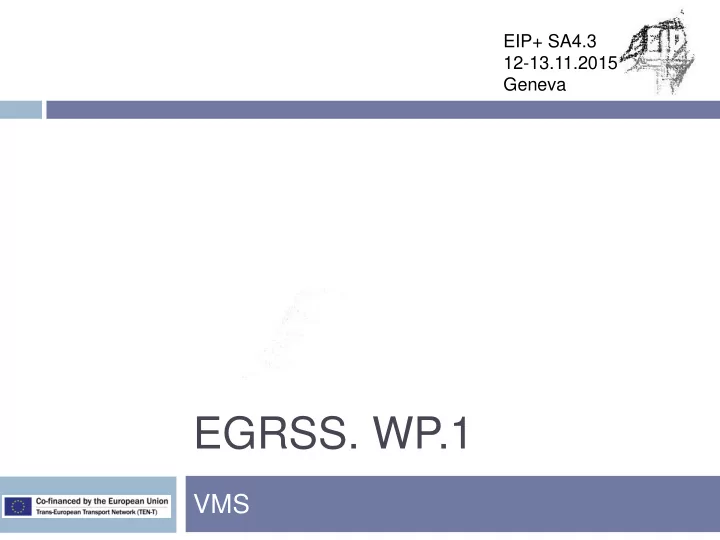

EIP+ SA4.3 12-13.11.2015 Geneva EGRSS. WP.1 VMS
Contents Issues concerning the possible enlargement of the 1968 Convention due to the advent of electronic road signage Position 1: worrying about it is unnecessary Position 2: anticipating solutions for some likely problems is necessary Conclusion Hybrid-VMS
Departure point Wind… Bad visibility… … Dangerous bend…
Departure point … that are nuanced by the Envisage the 1968 Convention as a book of road signs with core, specific context and the basic meanings … infrastructures displaying signs
Position 1: there’s no need to worry about specificities brought by electronic signage to the 1968 Convention 1. Because human (drivers) 2. Because the paint coat are able of inference outperforms any electronic matrix
Position 1: there’s no need to worry about specificities brought by electronic signage to the 1968 Convention Thought for the very good graphical nuances that paint makes possible, the collection of shapes, borders, rims, silhouettes, inscriptions, figures, panels, currently present in the 1968 Convention catalogue will surely satisfy the visual and representational needs of any coming electronic sign The 1968 Convention counts with a sufficient graphical richness to be sure
Position 2: anticipating solutions for some likely problems is necessary New display technologies introduce three basic needs: The need for new contents (signs and symbols) 1. demanded by electronic signage in particular The need to know specifically how to turn complex 2. signs on the 1968 Convention into signs that make sense for electronic signage The need to determine the way different and differing 3. reading schemes should be displayed simultaneously
First need : new contents demanded by electronic signage Annex X : new signs for use Annex IX : recommended on VMS signs of the Vienna Convention for use on VMS
First need : new contents demanded by electronic signage 2010 2011 2013 2015
Second need : the need to know how to turn current complex signs into e-signs Annex X : new signs for use Annex IX : recommended Advance Direction Signs on VMS signs of the Vienna Convention for use on VMS
Second need: the need to know how to turn current complex signs into e-signs Consider the 1995 amendment of the 1968 Convention (p. 51): “NOTE: Advance direction signs G, 1 may bear the symbols used on other signs informing road users of the characteristics of the route or of traffic conditions (for example: signs A, 2; A, 5; C, 3e; C, 6; E, 5a; F, 2).”
G, 1 c as model for e-signs: stack signs Stack signs: top-down or bottom up?
G, 1 c as model for e-signs: stack signs Poor e-signs: Hybrid-VMS. What to do?
G, 1 a ; G, 1 b as model for e-signs: diagrammatic signs “NOTE: Advance direction signs G, 1 may bear the symbols used on other signs informing road users of the characteristics of the route or of traffic conditions (for example: signs A, 2; A, 5; C, 3e; C, 6; E, 5a; F, 2).”
Third need: how should different and differing reading schemes be simultaneously displayed?
Third need: how should different and differing reading schemes be simultaneously displayed? This way?
Third need: how should different and differing reading schemes be simultaneously displayed? This way?
Conclusion Making explicit differences between signs within the 1968 1. Convention considering to their final use (as fixed, as electronic) is not actually necessary However, are there better and worse ways to make new e- 2. signs grow within the 1968 Convention? Clearly, not the elementary or simple signs, but the better 3. way to build up new complex road signs is the current challenge for the 1968 Convention
Conclusion There are at least three types of complex situations when using electronic signs: Qualitative location (analyzed in this document): 1. events going on towards, between, after certain locations ( Advance Location Signs ). This is pretty clear now Rerouting and detour (there are different types of it) 2. Strategic management: telling drivers in one road what 3. goes on in a adjacent or near road Analytical and empirical efforts should so be pursued
Recommend
More recommend